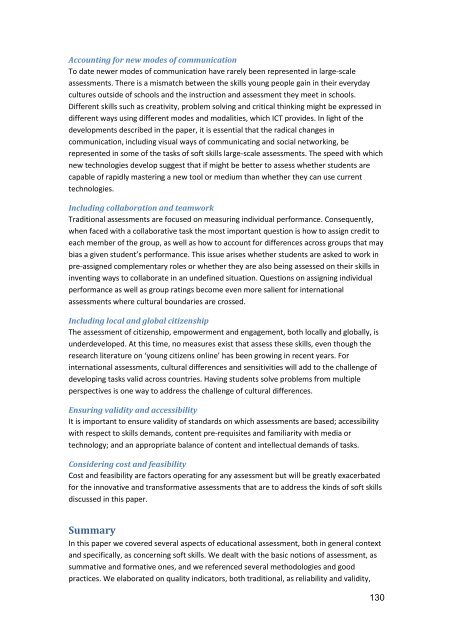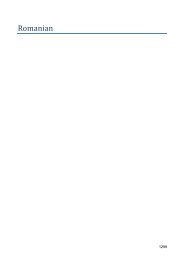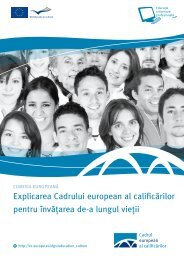Teaching and Assessing Soft Skills - MASS - Measuring and ...
Teaching and Assessing Soft Skills - MASS - Measuring and ...
Teaching and Assessing Soft Skills - MASS - Measuring and ...
Create successful ePaper yourself
Turn your PDF publications into a flip-book with our unique Google optimized e-Paper software.
Accounting for new modes of communication<br />
To date newer modes of communication have rarely been represented in large-scale<br />
assessments. There is a mismatch between the skills young people gain in their everyday<br />
cultures outside of schools <strong>and</strong> the instruction <strong>and</strong> assessment they meet in schools.<br />
Different skills such as creativity, problem solving <strong>and</strong> critical thinking might be expressed in<br />
different ways using different modes <strong>and</strong> modalities, which ICT provides. In light of the<br />
developments described in the paper, it is essential that the radical changes in<br />
communication, including visual ways of communicating <strong>and</strong> social networking, be<br />
represented in some of the tasks of soft skills large-scale assessments. The speed with which<br />
new technologies develop suggest that if might be better to assess whether students are<br />
capable of rapidly mastering a new tool or medium than whether they can use current<br />
technologies.<br />
Including collaboration <strong>and</strong> teamwork<br />
Traditional assessments are focused on measuring individual performance. Consequently,<br />
when faced with a collaborative task the most important question is how to assign credit to<br />
each member of the group, as well as how to account for differences across groups that may<br />
bias a given student’s performance. This issue arises whether students are asked to work in<br />
pre-assigned complementary roles or whether they are also being assessed on their skills in<br />
inventing ways to collaborate in an undefined situation. Questions on assigning individual<br />
performance as well as group ratings become even more salient for international<br />
assessments where cultural boundaries are crossed.<br />
Including local <strong>and</strong> global citizenship<br />
The assessment of citizenship, empowerment <strong>and</strong> engagement, both locally <strong>and</strong> globally, is<br />
underdeveloped. At this time, no measures exist that assess these skills, even though the<br />
research literature on ‘young citizens online’ has been growing in recent years. For<br />
international assessments, cultural differences <strong>and</strong> sensitivities will add to the challenge of<br />
developing tasks valid across countries. Having students solve problems from multiple<br />
perspectives is one way to address the challenge of cultural differences.<br />
Ensuring validity <strong>and</strong> accessibility<br />
It is important to ensure validity of st<strong>and</strong>ards on which assessments are based; accessibility<br />
with respect to skills dem<strong>and</strong>s, content pre-requisites <strong>and</strong> familiarity with media or<br />
technology; <strong>and</strong> an appropriate balance of content <strong>and</strong> intellectual dem<strong>and</strong>s of tasks.<br />
Considering cost <strong>and</strong> feasibility<br />
Cost <strong>and</strong> feasibility are factors operating for any assessment but will be greatly exacerbated<br />
for the innovative <strong>and</strong> transformative assessments that are to address the kinds of soft skills<br />
discussed in this paper.<br />
Summary<br />
In this paper we covered several aspects of educational assessment, both in general context<br />
<strong>and</strong> specifically, as concerning soft skills. We dealt with the basic notions of assessment, as<br />
summative <strong>and</strong> formative ones, <strong>and</strong> we referenced several methodologies <strong>and</strong> good<br />
practices. We elaborated on quality indicators, both traditional, as reliability <strong>and</strong> validity,<br />
130





